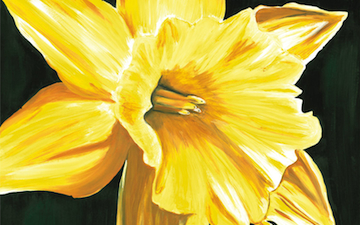Narcissus pseudonarcissus (commonly known as wild daffodil or Lent lily) is a perennial flowering plant of the family Amaryllidaceae which grows from a bulb. It has pale yellow flowers with a darker central trumpet. The long, narrow leaves are slightly greyish in colour and rise from the base of the stem. The species is native to Western Europe from Spain and Portugal east to Germany and north to England and Wales. It is commonly grown in gardens and populations have become established in many other parts of Europe. Wild plants grow in woods, grassland and on rocky ground. In Britain native populations have decreased substantially since the 19th century due to intensification of agriculture, clearance of woodland and uprooting of the bulbs for use in gardens. In Germany it was a subject of a nationally awareness campaign for the protection of wildflowers in 1981. There are a number of subspecies of the wild daffodil but the exact number varies according to different authors. The large number of cultivars adds to the difficulty of classification. Among the subspecies is the Tenby daffodil (N. p. ssp. obvallaris, sometimes classed as a separate species) which probably originated in cultivation but now grows wild in south-west Wales.
(From Wikipedia.org, October 25 2010)
– – –
Narcissus pseudonarcissus is the most variable species in the genus and includes many elements that sometimes have been recognized as separate species (e.g., H. W. Pugsley 1933). An old cultivated variety, “Telemonius Plenus,” with highly doubled flowers, commonly persists, although it does not reseed. Natural hybrids between N. pseudonarcissus and N. poeticus (N. ×incomparabilis Miller) have 1-flowered inflorescences and yellow flowers with the corona about half as long as the distinct portions of the tepals. They are known to persist in Kentucky, Louisiana, Mississippi, New Jersey, New York, North Carolina, Oregon, Pennsylvania, Texas, and Virginia. Natural hybrids between N. pseudonarcissus and N. jonquilla (N. ×odorus Linnaeus) have 1–4-flowered inflorescences and bright yellow flowers with the corona one-half to three-fourths as long as the distinct portions of the tepals. They are known to persist in Louisiana, South Carolina, Texas, and Virginia.
(From Missouri Botanical Garden via The Encyclopedia of Life, October 25 2010)
– – –




